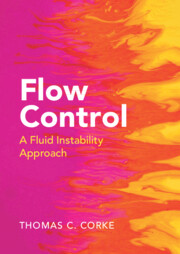Book contents
- Frontmatter
- Dedication
- Contents
- Preface
- 1 Introduction
- 2 Sensors and Actuators
- 3 Bluff Body Wakes
- 4 Separated Flows
- 5 Free Shear Layers and Jets
- 6 Two-Dimensional Laminar Boundary Layers
- 7 Three-Dimensional Laminar Boundary Layers
- 8 Turbulent Boundary Layers
- 9 Shock–Boundary-Layer Interaction
- 10 Flow Control by Design
- References
- Index
5 - Free Shear Layers and Jets
Published online by Cambridge University Press: 04 April 2024
- Frontmatter
- Dedication
- Contents
- Preface
- 1 Introduction
- 2 Sensors and Actuators
- 3 Bluff Body Wakes
- 4 Separated Flows
- 5 Free Shear Layers and Jets
- 6 Two-Dimensional Laminar Boundary Layers
- 7 Three-Dimensional Laminar Boundary Layers
- 8 Turbulent Boundary Layers
- 9 Shock–Boundary-Layer Interaction
- 10 Flow Control by Design
- References
- Index
Summary
Chapter 5 focuses on free shear layers and jets that involve the merging of two flow streams. Away from a boundary, the mean flow that results is inviscidly unstable and rapidly leads to the formation of coherent vortical structures that drive strong fluid mixing. In jets, it can result in large acoustic levels. Free shear layers are also highly sensitive to sound excitation that can lead to resonant growth of the instability, or a means of control. With this understanding, both passive and active methods of free shear layer control are presented.
Keywords
- Type
- Chapter
- Information
- Flow ControlA Fluid Instability Approach, pp. 175 - 219Publisher: Cambridge University PressPrint publication year: 2024

